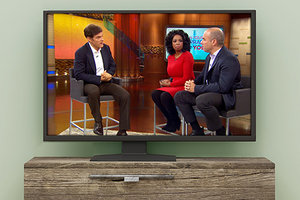Dr. Steven Shoshany's ninth appearance on "The Dr. Oz Show" may prove to be his most significant, as he addressed questions related to the death of Katie May, who suffered two strokes in February 2016, hours after her third visit to a chiropractor for what she described in a Twitter post as a pinched nerve in her neck experienced during a photo shoot days earlier.
Dr. Shoshany, a practicing chiropractor in New York City, appeared on the show on Nov. 16, 2016 following a segment featuring Ms. May's siblings (who said they believe the neck adjustment caused their sister's death, but to their credit, called it "an accident" and emphasized they were neither blaming the DC nor urging anyone to avoid seeing a chiropractor). Dr. Shoshany discussed the stroke issue with Dr. Oz and Dr. Carolyn Brockington, a neurovascular surgeon at Mt. Sinai Hospital in New York.
What Viewers Saw / Heard
 The Foundation for Chiropractic Progress provided an excellent synopsis of that discussion after reviewing the segment the day before it aired. Here are some highlights of the F4CP's media response:
The Foundation for Chiropractic Progress provided an excellent synopsis of that discussion after reviewing the segment the day before it aired. Here are some highlights of the F4CP's media response:
- "Dr. Shoshany expressed condolences to the family of Ms. May and went on to explain that the best science available suggests that this was a dissection in progress that occurred during the photo shoot involving Ms. May. He used a Bow-Hunter's Stroke as an example of the mechanism of causation – that is, the strain of maintaining a stressed position for a period yielded the injury. He related how rare these events are in chiropractic."
- "[Dr. Brockington] was asked point blank by Dr. Oz, 'Do you think manipulation caused the dissection?' She did not say the chiropractor caused this stroke. She did not raise undue concern about cervical spine adjusting. In response, she related that she, as a stroke specialist, sees strokes every day. Some of the strokes she sees have known causes and many don't. She related that she recently saw a gentleman who developed an arterial dissection while painting. She noted that these conditions can occur in seemingly healthy persons in their 30-50s with no prior history. She reviewed an angiogram to show what a dissection looked like on imaging and to explain how it was related to blood flow and oxygenation of the brain. She discussed that most dissections don't lead to stroke, but cervical artery dissection did account for 1 in 5 strokes in middle-aged persons."
- "Dr. Shoshany related that, as a clinician, Dr. Oz appreciated that the patient history was the most valuable tool we have to work with. He related the importance of knowing about a history of stroke, aneurysm, dissection, collagen disorders, etc. Dr. Oz then walked the audience through the 5 Ds, the 3 Ns and the A associated with cervical artery dissection [diplopia, dysphagia, dysarthria, drop attacks, dizziness; nausea, numbness, nystagmus; ataxia]. The advice given was that one should think of their neurologist or visiting the emergency room, rather than a chiropractor, when one has neck pain with these additional symptoms.
- "Dr. Shoshany [explained] that the profession has been addressing this situation for decades. He also added that he has delivered more than 200,000 cervical adjustments in his 20+ years of practice in Manhattan without a single occurrence of this problem. He added that Life University, the largest single-campus chiropractic program in the world, has provided an estimated 4.5 million cervical adjustments during the past 25 years without any incident of this nature. Finally, he added that among the 17 chiropractic educational programs in the United States, there has not been a single incident, to his knowledge, of this nature in the past 20 years."
- "Dr. Oz read a statement from the American Chiropractic Association (ACA) commenting on how DCs are educated and trained in differential diagnosis based on history, examination, etc., and that they are trained to refer when necessary for further evaluation or emergency intervention."
In Dr. Oz's closing remarks, he stated that "according to the American Heart Association, this is their official guidelines, neck manipulation may be associated with stroke." But similar to the May family's tone in the previous segment, he was quick to say, "That doesn't mean you have to avoid your chiropractor. It does mean you have to tell your chiropractor your full medical history so they can assess your risk of stroke."
The Chiropractic Takeaway
The Nov. 16, 2016 episode of "The Dr. Oz Show" is arguably the most informative (rather than accusatory) media handling of an adverse event involving chiropractic care and neck manipulation. To view the episode in its entirety (including the segment featuring Ms. May's siblings), click here. The complete F4CP media response is available here.
In its media response, the F4CP added these important takeaways for all DCs:
- "Make sure you are up to date with the current literature on this subject.
- Make sure your procedures fully appreciate the role of the 5 Ds, the 3 Ns and the A.
- Include questions about a history of stroke, aneurysm and dissection in the patient and their family in your case history and act accordingly.
- This is not the time to start your media career. Unless you have had extensive media training and you are intimately familiar with the literature on this subject, pass along any inquiries you receive to your state association, your chiropractic alma mater or other trusted resource for response.
- Don't be defensive. Answer patients' questions as they arise. Respect any request of you regarding their care – assuming it does not endanger them in some way."
Dynamic Chiropractic editorial staff members research, investigate and write articles for the publication on an ongoing basis. To contact the Editorial Department or submit an article of your own for consideration, email
.




